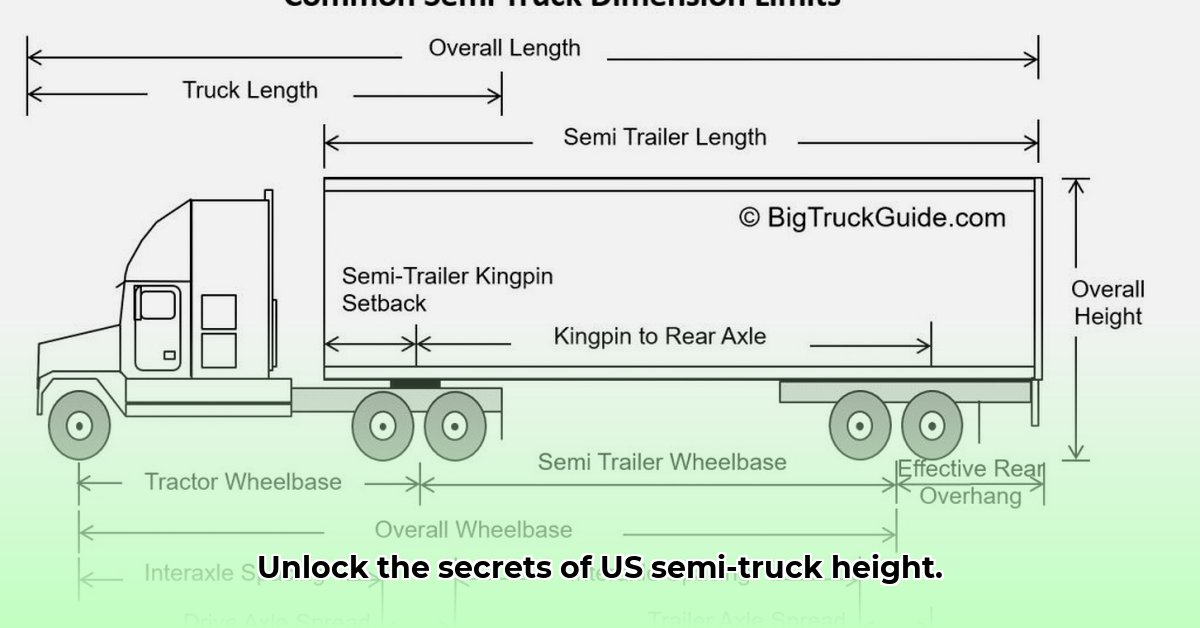
Understanding the height restrictions for semi-trucks in the US is crucial for safety and legal compliance. This comprehensive guide explores the complexities of semi-trailer heights, providing clear guidance for drivers, shippers, and anyone involved in the transportation industry. Ignoring these regulations can lead to accidents, hefty fines, and significant delays. So, let's delve into the details.
Height of Tractor-Trailer Trucks: Navigating the Regulations
The maximum legal height for a standard semi-trailer in the United States is often cited as 13.6 feet (4.15 meters). However, this seemingly simple answer masks a surprisingly complex landscape of regulations, trailer variations, and practical considerations. This guide clarifies these complexities, ensuring safe and efficient transportation.
Legal Height Limits: Beyond the Basic 13.6 Feet
While 13.6 feet serves as a general guideline, the actual legal height limit can vary based on several factors. These include the specific type of trailer, the state regulations, and any additional equipment mounted on the vehicle. For example, specialized trailers designed to carry oversized loads may have different height restrictions. This variation emphasizes the importance of consulting both federal and state Department of Transportation (DOT) regulations before each trip. Failing to do so could lead to significant legal and financial consequences. Have you ever wondered how many accidents are caused by exceeding these height limits? It's a significant contributor to preventable crashes.
Trailer Types and Their Height Variations
The height of a semi-truck depends heavily on the type of trailer it’s pulling. Several common trailer types exhibit significant height differences:
Dry Vans (Standard Cargo Trailers): These are the workhorses of the trucking industry, typically adhering to the 13.6-foot limit.
Flatbeds: These open trailers carry oversized or irregularly shaped loads, resulting in highly variable heights depending on the cargo.
Reefer Trailers (Refrigerated Trailers): Designed for temperature-sensitive goods, these trailers generally maintain a similar height to dry vans.
Lowboy/Double-drop Trailers: These are specifically engineered to carry exceptionally tall loads while remaining within legal limits due to their lower profile.
Step-deck Trailers: Featuring a raised front platform, these trailers accommodate oversized cargo, resulting in unique and variable heights.
Conestoga Trailers: The sliding roof on these enclosed trailers makes their height highly dependent on whether the roof is open or closed.
RGN (Removable Gooseneck) Trailers: Used for heavy and oversized items, these trailers often have a lower profile than standard trailers.
Accurate Measurement: A Critical Step for Safety and Compliance
Precise measurement is paramount for avoiding accidents and fines. Improper measurement can significantly increase the risk of collisions with low bridges or overpasses. Follow these steps for accurate measurement:
Utilize a reliable measuring tool: Employ a calibrated measuring tape or a laser measurement device for optimal precision. Guesswork is unacceptable.
Measure to the highest point: Include all features such as antennas, air conditioners, or any other equipment that extends above the trailer's primary structure.
Account for the load: The cargo significantly influences the overall height, requiring careful consideration and calculation.
Consult local regulations: State and local laws may impose stricter height limitations than federal regulations.
The Consequences of Exceeding Height Limits
The repercussions of exceeding legal height restrictions are far-reaching:
Accidents: Collisions with overpasses are a serious threat, leading to potential injury or fatality.
Damage: Contact with low-clearance objects can result in costly repairs to both the trailer and its cargo.
Delays: Becoming stuck under an overpass causes significant delays, disrupting delivery schedules and supply chains.
Fines and legal penalties: Penalties can be substantial, potentially impacting business operations and profitability.
Dr. Sarah Chen, PhD, Transportation Engineer at the Massachusetts Institute of Technology (MIT), states, "Precise measurement is not just about avoiding fines; it's about preventing potentially catastrophic accidents. The consequences of exceeding height restrictions extend far beyond the immediate financial penalties."
How to Accurately Measure Semi-Trailer Height for Compliance
Accurate semi-trailer height measurement is a crucial aspect of safe and legal operation. Here's a step-by-step guide:
Understand the Regulations: Begin by researching and understanding both federal and state height regulations. These can vary and it’s essential to comply with the strictest requirements for your planned route.
Choose Your Measurement Method: Select the most appropriate method based on your needs and resources. A standard tape measure can suffice for many situations, while laser measuring devices offer increased accuracy. Onboard height sensors offer convenience if available.
Accurate Measurement Technique: Regardless of method, adhere to strict measurement procedures. Ensure the trailer is level and unloaded during measurement. Measure from the ground to the absolute highest point.
Account for Oversized Loads: If the load exceeds height limits, obtain the necessary overheight permits from the relevant authorities. This involves detailed route planning and providing specifications of the load.
Driver Training and Route Planning: Driver training should include proper measurement techniques and awareness of height restrictions. Route planning software that incorporates height clearances is crucial to prevent accidents.
By implementing these steps, drivers and trucking companies can minimize risk and ensure full compliance with height regulations. The potential costs of non-compliance far outweigh the investment of time and resources in these practices.